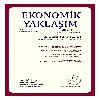Harcamaların Bölünmezliği ve Sigorta Yaptıran Kumarbaz
Indivisibilities and the Insurace Buying Gambler
___
- Appelbaum, E. ve Katz, E. (1981), "Market Constraints as a Rationale for the Friedman-Savage Utility Function", The Journal of Political Economy, 89, 819-25.
- Armstrong, W.E. (1939), "The Determinateness of the Utility Function", The Economic Journal, 49, 453-67.
- Bailey, M. J., Olson, M. ve Wonnacott, P. (1980), "The Marginal Utility of Income Does not Increase: Borrowing, Lending, and Friedman-Savage Gambles", The American Economic Review, 70, 372-79.
- Barro, R. J. (1976), "The Loan Market, Collateral, and Rates of Interest", Journal of Money, Credit and Banking, 8, 439-56.
- Benjamin, D. K. (1978), "The Use of Collateral to Enforce Debt Contracts". Economic Inquiry, 16, 333-59.
- Blume, M. E. ve Friend, I. (1975), "The Asset Structure of Individual Portfolios and Some Implications for Utility Functions", The Journal of Finance, 30, 585-603.
- Cochrane, J. H. (2001), Asset Pricing, Princeton University Press.
- Cohn, R. A., Lewellen, W. G., Lease, R.C. ve Schlarbaum, G.G. (1975), "Individual Investor Risk Aversion and Investment Portfolio Composition", The Journal of Finance, 30, 605-20.
- Fisher, I. (1930), The Theory of Interest, Nev York: Macmillan.
- Friedman, M. ve Savage, LJ. (1948), "The Utility Analysis of Choices Involving Risk", The Journal of Political Economy, 56, 279-304.
- Hartley, R. ve Farrell, L. (2002), "Can Expected Utility Theory Explain Gambling?", The American Economic Review, 92, 613-24.
- Hirshleifer, J. (1965), "Investment Decision Under Uncertainty: Choice-Theoretic Approaches". The Quarterly Journal of Economics, 79, 509-36.
- Hirshleifer, J. (1970), Investment, Interest and Capital, ABD: Prentice Hall.
- Kim, Y.C. (1973), "Choice in the Lottery-Insurance Situation Augmented Income Approach". Quarterly Journal of Economics, 87, 148-56.
- Kwang, N. Y. (1965), "Why do People Buy Lottery Tickets? Choices Involving Risk and the Indivisibility of Expenditure", The Journal of Political Economy, 73, 530-35.
- Neumann, J. V. ve Morgenstern, O. (1944), Theory of Games and Economic Behavior, Princeton University Press.
- Smith, A. (1937), The Wealth of Nations, Nev York: Random House.
- ISSN: 1300-1868
- Yayın Aralığı: 3
- Yayıncı: Ekonomik Yaklaşım Derneği
Bir "İktisatçı" nın Türk İletişim Araştırmalarına Katkıları: Sabri Ülgener Üzerine Notlar
Harcamaların Bölünmezliği ve Sigorta Yaptıran Kumarbaz
Farklı İşyeri Büyklüğündeki İmalat Sanayii Alt Sektörlerinde Enerji Yoğunluğu
Türkiye' de Eğitim Çağındaki Kız ve Erkeklerin Eğitimlerinin Sürdürülebilirliği
ÜÇDOĞRUK, M. Vedat PAZARLIOĞLU, Hamdi EMEÇ, Özlem KİREN
Usefulness of Monetary Aggregates Versus Interest Rates in Monetary Policy Formulations in Turkey
